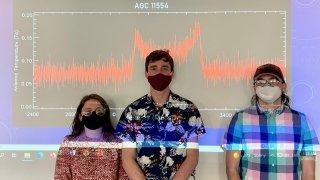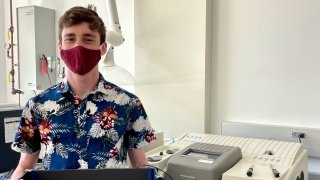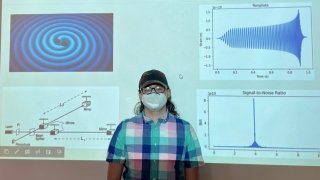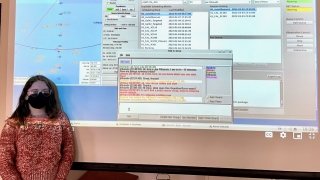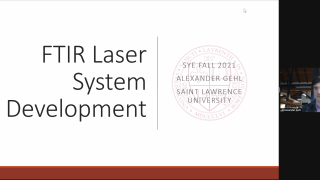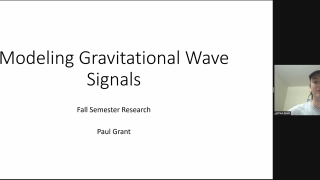Senior Research Projects 2021 - 2022
Seniors present to the physics department the results of their Phys 489/490: SYE Advanced Laboratory and Phys 499: Honors SYE research projects at the end of each semester. The abstracts for their research are below and photos of the student presenters follow afterwards:
Spring 2022
FTIR Excited State Analysis of Heterobinuclear Light Absorbers - Alexander Gehl '22
Artificial photosynthesis may be a crucial step forward in capturing CO₂ and generating renewable energy dense fuels. The electron dynamics and use for artificial photosynthesis of a heterobinuclear photoinduced charge separation units are discussed. The theory behind Fourier Transform infrared (FTIR) spectroscopy and the data provided by it are explained. A 405nm laser system was developed for use in FTIR analysis of excited-state charge separation units. One material, bipy-ZrOCo-SiO2, demonstrates spectral evidence of successful charge separation.
For more information, contact Dr. Catherine Jahncke or Dr. Adam Hill
Searching for Gravitational Waves - Paul Grant '22
In this paper, I will describe the research I have done this year with the assistance of Cristian Armendariz-Picon as my research supervisor. The majority of the first semester was spent learning about the mechanics behind gravitational waves and determining the best methods to reach our goal of finding potential gravitational wave signals in LIGO data and then determining possible sources of those signals. After a brief historical introduction to gravitational waves, I will describe the theory of general relativity and other relationships that we used that allowed us to create a model for predicting the gravitational wave signal from a given binary star system that a laser interferometer like LIGO would be able to detect. Then, I will describe the research I conducted during the second semester, which consisted of learning about matched-filters and how they are used to detect specific gravitational wave signals amongst LIGO strain data.
For more information, contact Dr. Cristian Armendariz-Picon
Remote Observation of Galaxies Hosting Supernovae with The Green Bank Telescope - Haille Perkins '22
For this project, we are observing galaxies hosting supernovae with the Green Bank Telescope in West Virginia. In the summer of 2021, we utilized the Democratic Sample of Supernovae (DSS, Stahl et al. 2021) to determine a catalog of host galaxies to observe. These galaxies are of interest because the supernovae they host can be used to obtain accurate distance measurements. Due to exploding white dwarfs, Type Ia supernovae show similar time evolutions and peaks in luminosity. Measurements of these, along with corrections for local environment, composition, and other factors, yield distance moduli that provide precise determinations of their distances. Currently, the Baryonic Tully Fisher Relation (BTFR), which demonstrated a relationship between a galaxy’s baryonic mass and its rotational speed, is used to determine distances to galaxies observed in various bands across the electromagnetic spectrum. However, there are issues with the level of uncertainty. Measurements of distances using methods such as variable stars, Hubble’s law, and others, are a large contributor to the uncertainty seen in the BTFR due to propagation of error. Additionally, these methods introduce selection bias, as each is only valid for galaxies selected for specific observational characteristics. With supernovae-derived distances and radio observations, we aim to make a generalized BTFR. This version will minimize selection bias and uncertainty since the sample includes galaxies hosting supernovae, rather than specific galactic characteristics and accurate distance measurements. This project has been allotted 132 hours of telescope time, and currently, 55 galaxies have been observed. In the coming summer, I will continue this work, as there are 111 hours of observations remaining. Additionally, I will begin the reduction of the incoming data.
For more information, contact Dr. Aileen O'Donoghue
Fall 2021
Development of a Laser System for FTIR Analysis of bipy-ZrOCo-SiO2 Heterobinuclear Light Absorbers - Alexander Gehl '22
Artificial photosynthesis may be a crucial step forward in order to capture CO2 and generate renewable energy dense fuels. The electron dynamics and usefulness for artificial photosynthesis of a heterobinuclear photoinduced charge separation unit, bipy-ZrOCo-SiO2, are discussed. The theory behind Fourier Transform Infrared Spectroscopy and the results provided by a 405nm laser system was
developed for use in FTIR analysis of excited-state charge separation units. Expected results are briefly discussed.
For more information, contact Dr. Catherine Jahncke or Dr. Adam Hill
Modeling Gravitational Wave Signals - Paul Grant '22
In this paper, I will describe the research I have done this semester with the assistance of Dr. Cristian Armendariz-Picon as my research supervisor. The majority of this semester was spent learning about the mechanics behind gravitational waves and determining the best methods to reach our goal of finding potential gravitational wave signals in LIGO data and then determining possible sources of those signals. After a brief historical introduction to gravitational waves, I will describe the theory of general relativity and other relationships that we used that allowed us to create a model for predicting the gravitational wave signal from a given binary star system that a laser interferometer like LIGO would be able to detect. Then, I will describe our plan for completing our research in the Spring semester.
For more information, contact Dr. Cristian Armendariz-Picon

